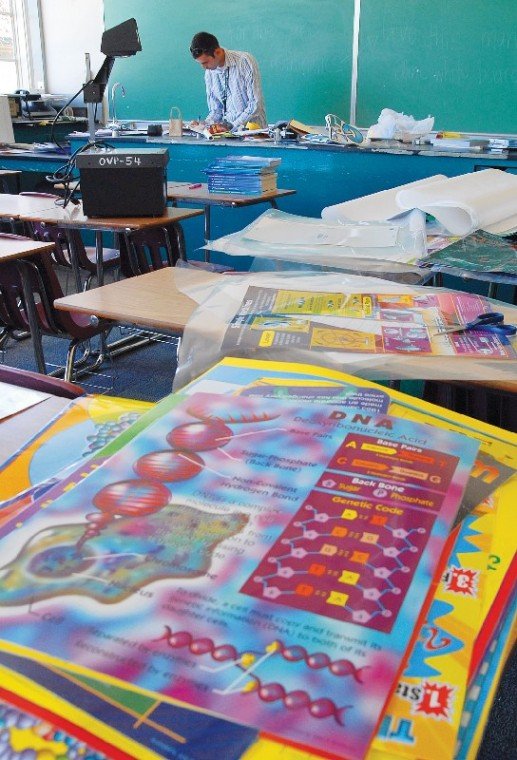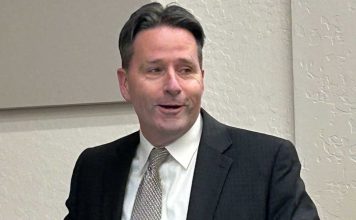While South Valley Middle School has posted significant gains on
state standardized tests during the past two years, English
learners’ poor performance might subject the school to drastic
federal measures, such as replacing its entire staff.
Gilroy – While South Valley Middle School has posted significant gains on state standardized tests during the past two years, English learners’ poor performance might subject the school to drastic federal measures, such as replacing its entire staff.
The situation has left administrators simultaneously cheering, fretting and wondering about test scores and their consequences.
“It’s as though we celebrate like heck on one hand, and we’re being kicked on the other,” said South Valley Principal John Perales.
A State Rock and a
Federal Hard Place
Based on state testing data released last week, district staff predict South Valley Middle School will gain 24 points on California’s Academic Performance Index. The state will not release the official point gain until Aug. 30, though past district predictions have been within one or two points. Regardless, the gain will likely exceed the state-required seven-point growth and is higher than typical annual growth of district schools. As South Valley also posted a 24-point gain last year, during a two-year period where it was expected to grow 14 points, the school gained 48 points.
“That’s growth that when I went to a conference (of administrators) a few weeks ago, people wish they had,” Perales said.
District staff predict the school scored 713 on the state index, above the 700 mark that reflects an average student score of basic – a step below the state target of 875, which is considered proficient. The school scored as low as 656 in 2004.
However, significant gains on standardized tests might not be enough to keep South Valley from being put into year four “program improvement” – a federal designation that the school is not meeting test expectations. This label means the government could impose drastic measures, such as replacing the entire school staff or taking over its administration.
The reason South Valley might go into year four is because of English learners – students for whom English is not their first language. The percentage of them who were proficient in language arts and math was not high enough to meet federal standards, Perales said. Low English learner performance drove South Valley – which has the highest population of English learners in district middle schools at 28 percent – to year three program improvement last August.
“We have to work to meet those kids’ needs,” said Perales, a former English learner.
Difficult by Definition
One complication of meeting those children’s needs is that the group is defined as English learners who perform poorly, assistant superintendent of curriculum and instruction Basha Millhollen said at a board meeting. If English learners score high enough on district and state tests, they are reclassified as fluent English proficient. Thus, unlike other groups where high-performing students can offset low-performing students, the English learner group lacks the highest-achieving students and suffers a lower average score, Perales said.
School staff will look to “tighten up the curriculum” and make certain English learners get individualized attention, Perales said. Staff will follow these strategies even if official test results confirm district predictions that South Valley is in year four program improvement. Neither Perales nor trustees have selected which drastic measure they would choose to impose on the school. However, trustees said school staff and administrators were hard-working and replacing either would not help improve the school.
“They obviously did some things right,” trustee Francisco Dominguez said. “Now they just need to redirect their focus.”
Dominguez expects that the board and district staff will meet in early September to discuss program improvement options at South Valley if official results confirm district predictions.
District Superintendent Deborah Flores did not return a dozen calls placed to her office as of 7pm Tuesday.
A National Issue
The situation at South Valley magnifies the unrealistic expectations of the federal accountability system, known as No Child Left Behind, administrators and staff said. Each year, the bar that schools must meet to stay out of program improvement is raised, with the end goal of having all schools having all students proficient by 2014. This is an impossible goal because there will always be students that struggle, Perales said. Accordingly, sanctions to enforce these unrealistic expectations are often not fair, he said.
“I can take punitive measures any day,” he said. “But when punitive measures are held to as lofty a goal as 100 percent proficiency, I have a problem with that.”
South Valley’s situation also highlights the increased pressure to focus on testing that the state places on teachers and administrators. Teachers at every level have complained that preparing students for standardized tests eats up instructional time.
South Valley spent about two weeks last spring preparing students for state standardized tests, using games, prizes and T-shirts to pump up students and teachers.
For second-year, sixth-grade math and science teacher Rachael Cornaggia, going into the next level of program improvement would not change the fundamental charge of teachers.
“If we end up going into that level, all we have to do is focus on getting out of it,” she said. “We’ll all work together.”
The key is to focus on the successes, Cornaggia said.
“We gained a lot since last, year – that’s all you can really ask for,” she said.















